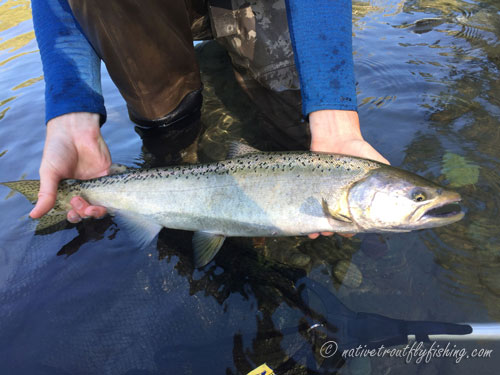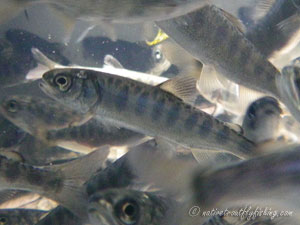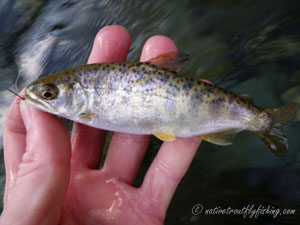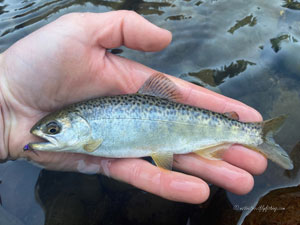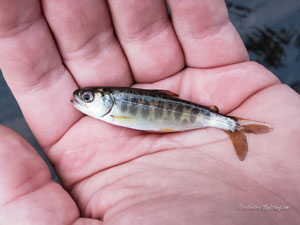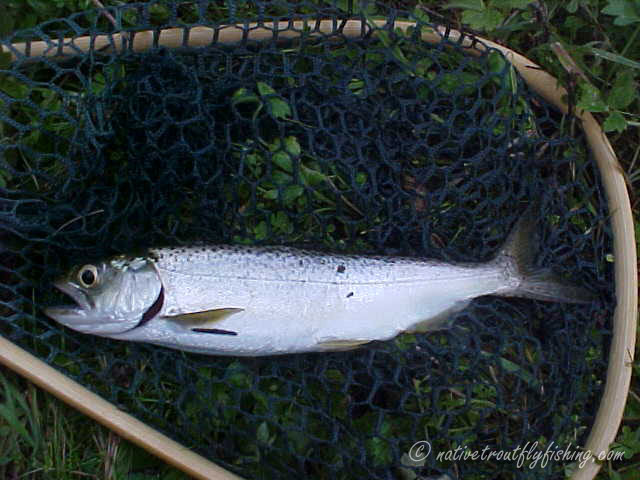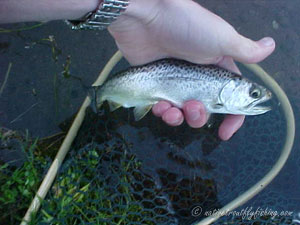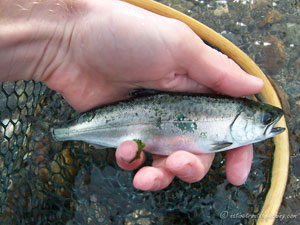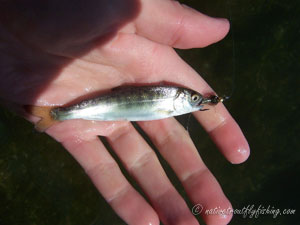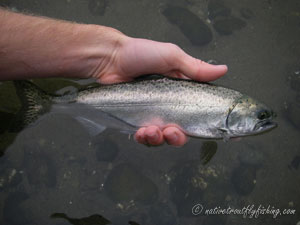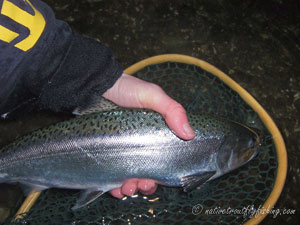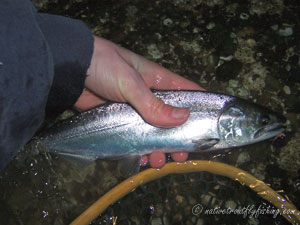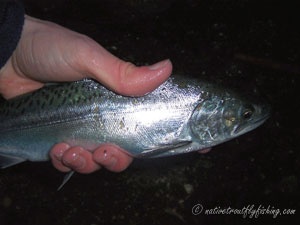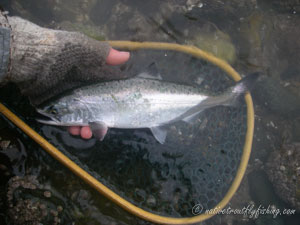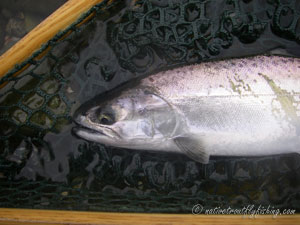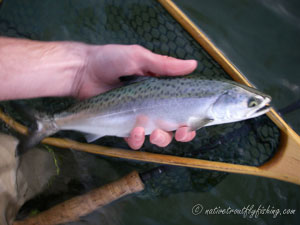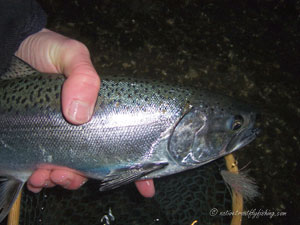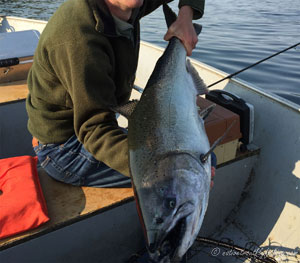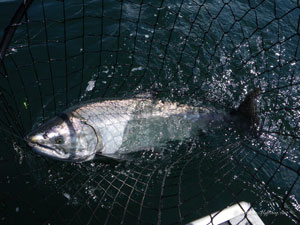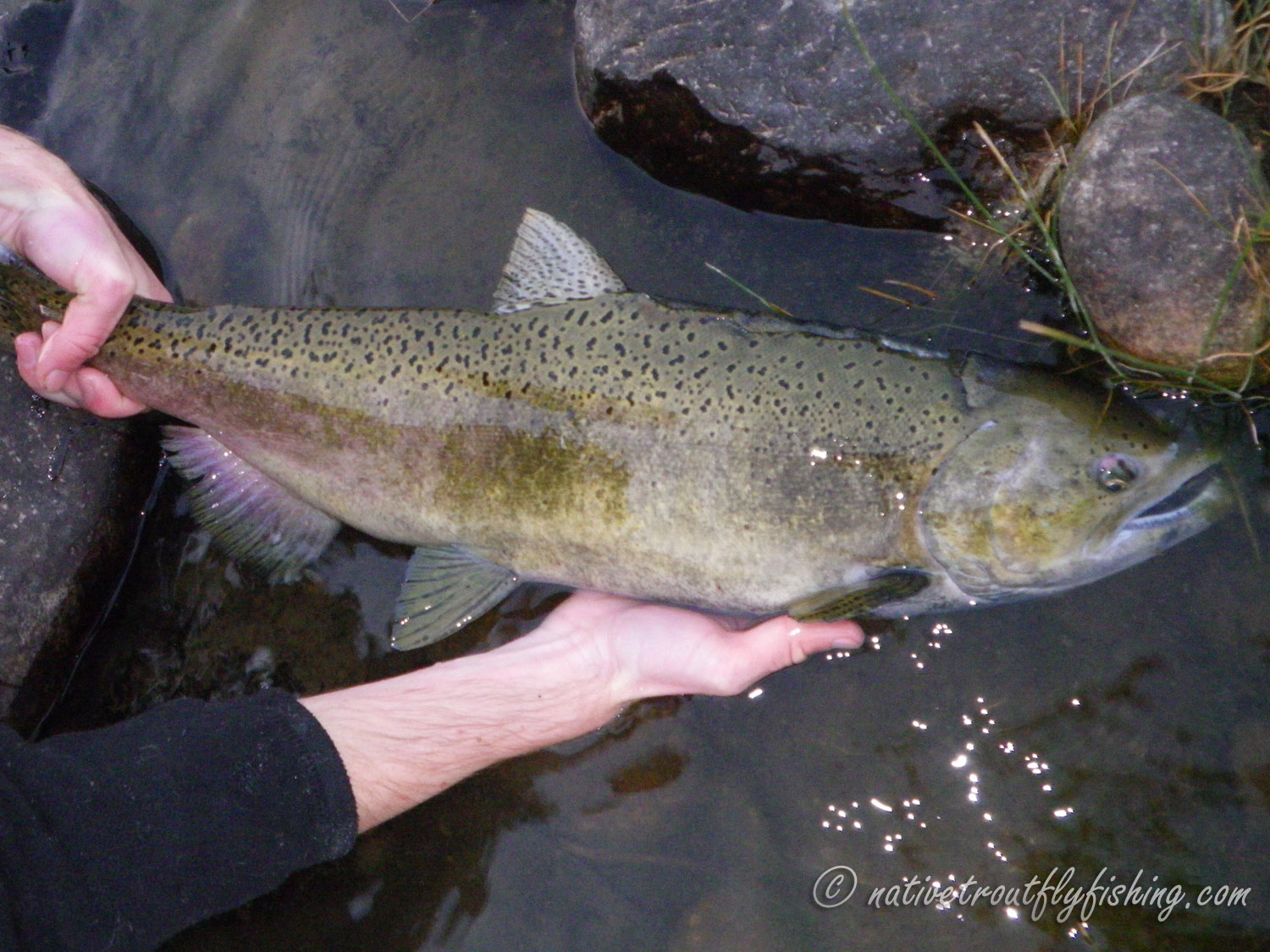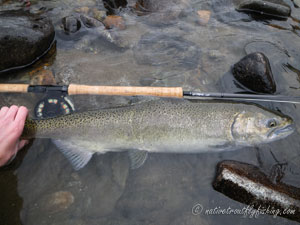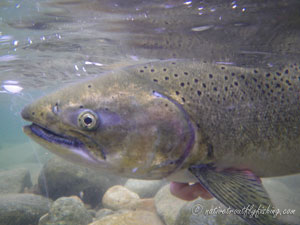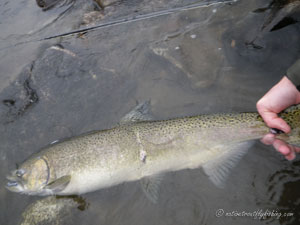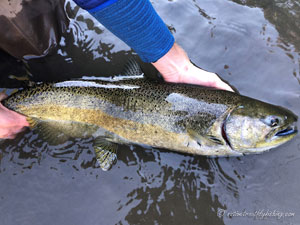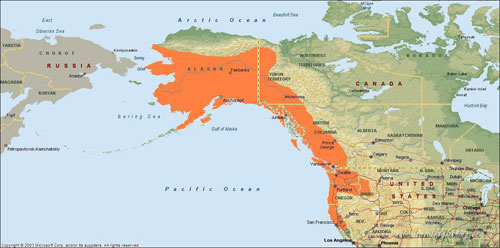Chinook Salmon
Oncorhynchus tshawytscha
An adult male fall Chinook Salmon caught near the mouth of a river
Introduction
Chinook salmon are the largest species of Pacific salmon and can attain weights in excess of 100 pounds, with the largest commercial caught fish weighing 126 lbs. (57.2 kg) and the largest sport caught fish weighing 97 lbs. (44.0 kg ). These giant Chinook are more of an anomaly than the norm and most adult fish are much smaller, averaging between 10 to 25 lbs. (4.5 – 11 kg) and 28" to 40" (71 – 122 cm) (Behnke 2002). The native range of Chinook in North America extends from Monterey Bay, California to Point Hope, Alaska and in Asia from Hokkaido, Japan to Anadyr River in Russia (Watson 1999). Chinook have also been introduced outside of their native range and have become established in the Great Lakes, USA, New Zealand and Patagonia, South America. Due to their size and life history patterns, Chinook are the least abundant species of Pacific salmon and historically the most robust populations were in large river systems such as the Yukon, Kenia, Fraser, Columbia and Sacramento-San Joaquin. Chinook salmon are prized as a food fish as well as sport fish and are harvested extensively across their range. Other common names for Chinook include king salmon (most common), blackmouth (immature fish in saltwater), Quinnat salmon, spring salmon and Tyee salmon.
Life History Information
Chinook salmon exhibit a wide variety of life history strategies and while the overwhelming majority of these fish are anadromous they have adapted to make the most of their environment. Much of this diversity occurs with how Chinook utilize their spawning habitat. Most Chinook salmon spawn during the fall, with the bulk of the spawning activity occurring between September and November (Behnke 2002). Spring spawning runs are also fairly common across the native range of Chinook salmon and these fish generally arrive during April and June and than spawn during late summer or early fall. These differences in run timings are largely due to the type of habitat that is used by the spring and fall run fish. Spring Chinook tend to spawn near the headwaters of streams in areas that are inaccessible except during the high flows of spring run-off. The fall Chinook on the other hand generally utilize the lower reach of rivers as spawning and rearing habitat, allowing them arrive during the lower flow periods that typically occur during late summer and early fall. One river of note for Chinook salmon is the Sacramento which has four distinct spawning runs corresponding with each season; winter, spring, summer and fall. While Chinook salmon are considered a fall spawning fish, the winter run fish from the Sacramento River generally arrive in January and February and spawn during May. This population represents the only native population of chinook known to spawn during the spring (Behnke 2002). Once Chinook reach the inner estuary of their spawning stream they stop feeding, a behavior which is common to all Pacific salmon. Some populations of Chinook spawn very far from the ocean, and have been noted to spawn between 1000 and 2000 river miles upstream ocean in the Columbia and Yukon River systems. Chinook salmon tend to utilized larger streams and rivers for spawning habitat and are even known to spawn in the main stem of the Columbia River.
Chinook salmon populations are usually broken up into stream type and ocean type fish depending on the age at which they migrate to sea. Stream type fish generally reside in their natal stream for anywhere from one to three years. While ocean type fish migrate to sea within their first year and are more common in the southern part of the Chinook's native range where there is a higher growth rate. In the Columbia River system these two forms correlate with the fall and spring spawning runs as well. The fall Chinook of the Columbia River and the spring Chinook of the lower Columbia belong to the ocean type lineage while the spring run fish of the mid and upper Columbia and Snake River systems belong to the stream type lineage (Utter et al. 1995). Teel et al. (2000) showed that these two life history types are genetically distinct, and it is thought that they arose from geographic isolation during the Pleistocene glaciations.
Although rare, Chinook salmon also have a stream resident life history pattern where the parr (juvenile fish) stay in the stream until adulthood instead of migrating to sea. Once the smolts enter the saltwater, they often spend some time feeding in the estuaries (generally in the spring). While some Chinook salmon remain in estuarine waters near their home river most travel further out to sea. The general trend for Chinook salmon is to travel northward from their home stream while remaining in coastal waters (Quinn 2005). This is just a general trend though, and catch records from fishing on the high seas indicate that a large number of Chinook salmon do travel out to offshore waters as well. In the Puget Sound, there is an estuarine life history form known as "blackmouth," which matures in the waters of the sound instead of traveling further out to sea. Chinook in the saltwater show a low tolerance to light, and are generally found in deeper water than the other four species of salmon. In the ocean their diet is largely made up of other fish (60 - 70%) but they also feed on crustaceans, which make up the remaining 30 - 40% of their diet. Most Chinook return to spawn at two to five years of age, with some returning at up to eight years old.
Genetically speaking, both Chinook and coho are more closely related to trout than the other North American species of Pacific salmon. While Chinook have never been documented to survive to spawn more than once in the wild, under hatchery conditions stream resident male Chinook parr have been shown to have the ability to spawn up to three times (Unwin et al. 1999). Although hybridization with other species of salmon is rare, Chinook have been documented to hybridize with both coho and pink salmon most likely due to hatchery stock influences. This hybridization appears to occur on a more regular basis in the Great Lakes where both Chinook and pink salmon were introduced and produce a hybrid fish commonly called pinook salmon.
Status
Currently Chinook populations are depressed throughout much of their native range. Over the past century approximately 54% of spring and summer run and 21% of fall and winter run Chinook populations have gone extinct (Gustafson et al. 2007). Of the remaining natural populations, 17 of the recognized evolutionarily significant units (ESU) of Chinook salmon in Washington, Oregon, Idaho and California, two are listed as endangered, and seven are listed as threatened (NOAA, 2007). The causes of the decline of Chinook salmon can be traced back mainly to the four H's. In the Columbia River system, hydroelectric dams have severally limited the abundance of Chinook salmon. The Grand Coulee dam alone in eastern Washington which was built without a fish ladder cut off access to over 1,000 miles of spawning and rearing habitat. To reach the uppermost spawning grounds in the Columbia River system, Chinook must travel over nine dams. A study done on hatchery Chinook smolts in the Snake and Columbia River systems showed that there is about a 6% to 11% mortality rate at each dam (Muir et al. 2001). Some of the causes of this mortality include damage from contact with the turbines, delayed migration timing due to the slack water behind the dams, and increased predation. When you add in the damaged done to Chinook populations by habitat destruction, hatchery fish, and over harvest, it is easy to see why so many populations are in trouble.
Description
Chinook salmon have irregular shaped and sized black spots, which are generally concentrated above the lateral line, and across their dorsal and caudal (tail) fins. Juvenile Chinook salmon in freshwater, have olive to greenish-brown backs and silvery sides with nine to eleven oval parr marks across their sides. As they smolt, their parr marks fade and they become more silvery to provide better camouflage in preparation for their marine journey (Haner et al. 1995). During the marine phase of their life cycle, this bright silver coloration predominates and they have a dark mouth with black gums at the base of their teeth, which are rather large and sharp (WDFW 2006). When adults return to freshwater, their appearance begins to change as they prepare to spawn. They begin to color up, which can be a bronze or reddish brown or maroon color to black on their sides. Additionally males develop a kype with larger teeth and a slight hump to their back, to prepare them to fight for mates. The development of these spawning characteristics varies between watersheds and when they develop depends on the run type. Spring Chinook will remain silvery for quite some time in freshwater, while fall Chinook often begin showing these characteristics as they approach freshwater.
Fly Fishing Information
Although Chinook salmon can caught on the flies under the right conditions, they are not nearly as receptive or readily available as coho, pink or chum salmon.
Saltwater
Chinook are very sensitive to light and tend to inhabit deeper water while in marine waters, often far from shore, placing them out of the reach of beach anglers most of the time. When Chinook are still offshore and actively feeding, they are much more likely to take flies. Off the Pacific Coast, trolling baitfish patterns or cast flies into bait-balls can produce results. In the Puget Sound, resident Chinook (blackmouth) can be caught from shore with the right tactics. For anglers that willing to miss some sleep, these fish can often be found near shore during low light conditions and will aggressively attack flies. When targeting Chinook at night, glow in the dark or black baitfish, shrimp or squid patterns all work well.
Freshwater
Once in freshwater Chinook salmon do not feed and can be quite "lock-jawed" at times. As such, triggering fish to bite can often be a matter of inducing their aggression. Certain colors will often trigger them to hit flies, with popular colors being black, purple, pink and orange. In rivers these fish generally like to hold in runs and deep pools and are commonly targeted will sink tip lines and a wide array of streamers. Nymph fishing can also be quite effective at times, with egg imitations and even some stonefly nymphs working under the right conditions.
Parr Stage
Click on images to view a larger picture
Smolt Stage
Estuarine Resident
Ocean Phase
Spawning Stage
Native Range
A map of the native range of Chinook salmon in North America. Data Sources: Behnke (2002) and Augerot et al. (2005).
References
Augerot, X., D.N. Foley, C. Steinback, A. Fuller, N. Fobes and K. Spencer. 2005. Atlas of Pacific Salmon: The First Map-Based Status Assessment of Salmon in the North Pacific. University of California Press, Berkeley.
Behnke, R. and T. McGuane. 2002. Trout and Salmon of North America. Chanticleer Press, New York
Bourret, S.L., C.C. Caudill and M.L. Keefer. 2016. Diversity of juvenile Chinook salmon life history pathways. Reviews in Fish Biology and Fisheries 26(3): 375. https://doi.org/10.1007/s11160-016-9432-3
Gustafson R.G., R.S. Waples, J.M. Myers, L.A. Weitkamp, J.J. Bryant, W. Orlay and J.J. Hard. 2007. Pacific salmon extinctions: quantifying lost and remaining diversity. Conservation Biology 21:1009–1020.
Haner, P.V., J.C. Faler, R.M. Schrock, D.W.Rondorf and A.G. Maule. 1995. Skin reflectance as a nonlethal measure of smoltification for juvenile salmonids. North American Journal of Fisheries Management 15: 814-822.
Healey, M.C. 1991. Life history of Chinook salmon (Oncorhynchus tshawytscha). In: Groot C, Margolis L (eds) Pacific salmon life histories. University of British Columbia Press, Vancouver, pp 313–393.
Healey M.C. 1994. Variation in the life history characteristics of Chinook salmon and its relevance to conservation of the Sacramento winter run of Chinook salmon. Conservation Biology 8:876–877.
Kjelson M.A., P.F. Raquel, F.W. Fisher. 1982. Life history of fall-run juvenile Chinook salmon, Oncorhynchus tshawytscha, in the Sacramento-San Joaquin estuary, California. In: Kennedy VS (ed) Estuarine comparisons. Academic Press, New York, pp 393–411.
Lister, D.B. and H.S. Genoe. 1970. Stream habitat utilization by cohabitating underyearlings of Chinook (Oncorhynchus tshawytscha) and coho (O. kisutch) salmon in the Big Qualicum River, British Columbia. Journal of the Fisheries Research Board of Canada. 27: 1215-1224.
Muir, W.D., S.G. Smith, J.G. Williams and E.E. Hockersmith. 2001. Survival estimates for migrant yearling chinook salmon and steelhead tagged with passive integrated transponders in the lower Snake and lower Columbia Rivers, 1993-1998. North American Journal of Fisheries Management 21: 269-282.
Quinn, T. 2005. The Behavior and Ecology of Pacific Salmon and Trout. University of Washington Press, Seattle.
Teel, D.J., G.B. Milner, G.A. Winans and W.S. Grant. 2000. Genetic population structure and origin of life history types in Chinook salmon in British Columbia, Canada. Transactions of the American Fisheries Society 129:194-209.
Unwin, M.J., M.T. Kinnison and T.P. Quinn. 1999. Exceptions to semelparity postmaturation survival, morphology, and energetics of male Chinook salmon. Canadian Journal of Fisheries and Aquatic Sciences 56 (7): 1172-1181.
Utter, F. M., D.W. Chapman and A.R. Marshall. 1995. Genetic population structure and history of Chinook salmon of the upper Columbia River. American Fisheries Society Symposium 17: 149-165.
Watson, R. 1999. Salmon, Trout & Charr of the World: A Fisherman's Natural History. Swan Hill Press, Shrewsbury, England.
WDFW (Washington Department of Fish and Wildlife). 2006. Chinook (King) Salmon. Obtained from: https://wdfw.wa.gov/fishing/salmon/chinook.html
Contact
Feel free to contact me if you have any questions or comments
Native Trout Links
Truchas Mexicanas' - Native Trout of Mexico
Balkan Trout Restoration Group
Trout and Seasons of the Mountain Village - About Japanese Trout
Western Native Trout Challenge
California Heritage Trout Challenge
Fly Fishing Blogs
Dave B's Blog: Fly Fishing for Native Trout
The Search for Native Salmonids
Conservation Links
Western Native Trout Initiative
Fly Fishing Links
Fishing Art Links
Americanfishes.com - Joseph R. Tomelleri
